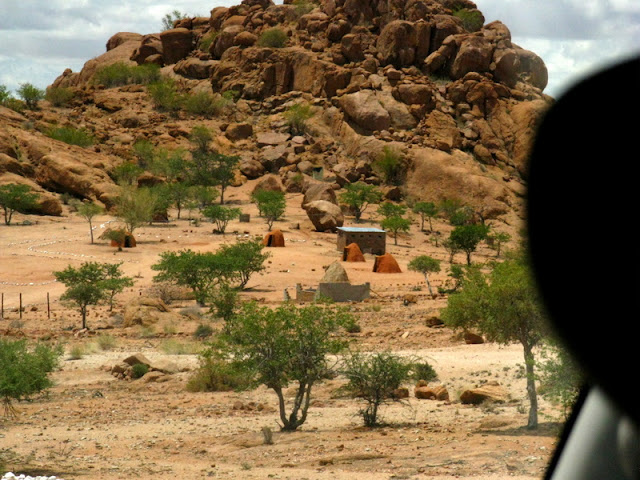We left Swakopmund early in the day so we could squeeze in a trip to Cape Cross and still get to Aabadi Mountain Camp by nightfall. As we turned to leave Swakopmund, we saw the last of the marine-motif holiday decorations
and headed for the salt road to Hentiesbaai and Cape Cross. Salt roads, as it turns out, are amazingly smooth. It was like driving on the silky smooth linoleum -- but with traction.
Cape Cross is due north of Swakopmund and home to 80,000 to 100,000 Cape Cross fur seals. New seal pups had been born anywhere from a few weeks to a few days before we arrived. The beach was speckled brown and black with mothers, babies, and huge, assertive males.
We were able to park our truck right near the shore rocks and had to step over sunbathing babies to get to the visitor boardwalk through the area (something you would never be allowed to do in the US!). It was not only smelly but loud at Cape Cross.
This many seals vocalizing almost drowns out the equally loud patch of pretty rough sea. The babies’ cries were a cacophony ranging from the sound of crying human babies to crying seal pups to bleating lambs to mooing cattle. Many babies sleep and hang out under the boardwalk. Walking on the boardwalk directly over them was unnerving; their calls vibrated up from below our feet making us feel we were literally trouncing on seal pups with every step!
Loads of photos later, we headed back to Hentiesbaai to reconnect with C35 northwest toward Aabadi Mountain Camp. Not long after leaving Hentiesbaai, the road smooths out to an arrow straight path through desolate, empty landscape.
We thought stretches of the American southwest were desolate but they hold not a candle to this uberdesolation. For a solid 104 kilometers the only thing that identified the roadway was the long line of telephone poles paralleling the road in echoing straightness, converging to the same vanishing point as the roadway.
By noon, it was clear there was going to be no shady spot for a picnic lunch so we stopped at a rest stop at the side of the road to grab a quick lunch and to walk in the empty landscape long enough to know what it feels to be surrounded by nothing but sand.
Walking up to it from a distance, the rest stop's rusted, shot-up sign looked like a TV monitor inexplicably placed in the middle of an alien, surreal landscape – a conduit to a familiar civilization that seemed light years away from this spot.
After lunch, we drove through more straight line roadway until finally, hilly regions began to appear ahead and toward mid-afternoon, the scenery morphed into the hilly ranges of Damaraland.
More and more hills began to appear as we entered Damaraland. We saw beautiful mountains out the windows as well as Himba and Herero settlements just off the road.
We stopped by the side of the road to meet this lovely Herero lady and her son selling their crafts to passersby.
Donkey cart drivers waved as we passed
and the roads got more and more hilly
until we reached the crest of a hill that led down the other side to the turn off to Aabadi Mountain Camp.
Aabadi is a great little rustic campground with friendly proprietors and a location in a dry river bed that the famous desert elephants frequent in the dry season. We arrived just as the rainy season was approaching and the elephants had already moved north out of the area.
We set up the tents for the night and retreated to the restaurant/bar tent for Rock Shandies and Windhoek Drafts.
It was hot that afternoon – temperatures were in the high 90’s F with humid breezes blowing in off of nearby thunderstorms about to initiate the rainy season in this hilly country.
As sunset began to color the hill just across from the reception/restaurant tent, they called us to dinner.
 Unfortunately for readers of this post, we were enjoying our amazing dinner of excellent peanut soup, spicy bobotie, and cinnamon flavored milk tart far too much to stop to take pictures of the food. You’ll have to take our word for it…the cook at Aabadi is one talented lady. Every morsel was scrumptious.
Unfortunately for readers of this post, we were enjoying our amazing dinner of excellent peanut soup, spicy bobotie, and cinnamon flavored milk tart far too much to stop to take pictures of the food. You’ll have to take our word for it…the cook at Aabadi is one talented lady. Every morsel was scrumptious. We walked back to our tents under deep indigo skies hung with millions of stars and the Milky Way and Magellanic Clouds we had last seen in Sesriem. When living in a city, you forget the magical light show the night sky puts on each evening. It was good to have the chance to look up and relish it again this night.






































































